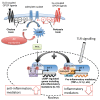Adenylate Cyclases of Trypanosoma brucei, Environmental Sensors and Controllers of Host Innate Immune Response
- PMID: 29693583
- PMCID: PMC6027212
- DOI: 10.3390/pathogens7020048
Adenylate Cyclases of Trypanosoma brucei, Environmental Sensors and Controllers of Host Innate Immune Response
Abstract
Trypanosoma brucei, etiological agent of Sleeping Sickness in Africa, is the prototype of African trypanosomes, protozoan extracellular flagellate parasites transmitted by saliva (Salivaria). In these parasites the molecular controls of the cell cycle and environmental sensing are elaborate and concentrated at the flagellum. Genomic analyses suggest that these parasites appear to differ considerably from the host in signaling mechanisms, with the exception of receptor-type adenylate cyclases (AC) that are topologically similar to receptor-type guanylate cyclase (GC) of higher eukaryotes but control a new class of cAMP targets of unknown function, the cAMP response proteins (CARPs), rather than the classical protein kinase A cAMP effector (PKA). T. brucei possesses a large polymorphic family of ACs, mainly associated with the flagellar membrane, and these are involved in inhibition of the innate immune response of the host prior to the massive release of immunomodulatory factors at the first peak of parasitemia. Recent evidence suggests that in T. brucei several insect-specific AC isoforms are involved in social motility, whereas only a few AC isoforms are involved in cytokinesis control of bloodstream forms, attesting that a complex signaling pathway is required for environmental sensing. In this review, after a general update on cAMP signaling pathway and the multiple roles of cAMP, I summarize the existing knowledge of the mechanisms by which pathogenic microorganisms modulate cAMP levels to escape immune defense.
Keywords: TNF-α; Trypanosoma brucei; adenylate cyclase; cAMP signaling; inflammation; innate immunity.
Conflict of interest statement
The author declares no conflict of interest.
Figures




Similar articles
-
Insect stage-specific receptor adenylate cyclases are localized to distinct subdomains of the Trypanosoma brucei Flagellar membrane.Eukaryot Cell. 2014 Aug;13(8):1064-76. doi: 10.1128/EC.00019-14. Epub 2014 May 30. Eukaryot Cell. 2014. PMID: 24879126 Free PMC article.
-
Functional Analyses of Cytokinesis Regulators in Bloodstream Stage Trypanosoma brucei Parasites Identify Functions and Regulations Specific to the Life Cycle Stage.mSphere. 2019 May 1;4(3):e00199-19. doi: 10.1128/mSphere.00199-19. mSphere. 2019. PMID: 31043517 Free PMC article.
-
Adenylate cyclases of Trypanosoma brucei inhibit the innate immune response of the host.Science. 2012 Jul 27;337(6093):463-6. doi: 10.1126/science.1222753. Epub 2012 Jun 14. Science. 2012. PMID: 22700656
-
The ever unfolding story of cAMP signaling in trypanosomatids: vive la difference!Front Pharmacol. 2015 Sep 7;6:185. doi: 10.3389/fphar.2015.00185. eCollection 2015. Front Pharmacol. 2015. PMID: 26441645 Free PMC article. Review.
-
A Host-Pathogen Interaction Reduced to First Principles: Antigenic Variation in T. brucei.Results Probl Cell Differ. 2015;57:23-46. doi: 10.1007/978-3-319-20819-0_2. Results Probl Cell Differ. 2015. PMID: 26537376 Review.
Cited by
-
In silico evolutionary and structural analysis of cAMP response proteins (CARPs) from Leishmania major.Arch Microbiol. 2023 Mar 20;205(4):125. doi: 10.1007/s00203-023-03463-6. Arch Microbiol. 2023. PMID: 36941487
-
Large-Scale Phylogenetic Analysis of Trypanosomatid Adenylate Cyclases Reveals Associations with Extracellular Lifestyle and Host-Pathogen Interplay.Genome Biol Evol. 2020 Dec 6;12(12):2403-2416. doi: 10.1093/gbe/evaa226. Genome Biol Evol. 2020. PMID: 33104188 Free PMC article.
-
Comparative transcriptomics and host-specific parasite gene expression profiles inform on drivers of proliferative kidney disease.Sci Rep. 2021 Jan 25;11(1):2149. doi: 10.1038/s41598-020-77881-7. Sci Rep. 2021. PMID: 33495500 Free PMC article.
-
Beyond the VSG layer: Exploring the role of intrinsic disorder in the invariant surface glycoproteins of African trypanosomes.PLoS Pathog. 2024 Apr 22;20(4):e1012186. doi: 10.1371/journal.ppat.1012186. eCollection 2024 Apr. PLoS Pathog. 2024. PMID: 38648216 Free PMC article.
-
TcCARP3 modulates compartmentalized cAMP signals involved in osmoregulation, infection of mammalian cells, and colonization of the triatomine vector in the human pathogen Trypanosoma cruzi.bioRxiv [Preprint]. 2024 Nov 21:2024.11.20.624561. doi: 10.1101/2024.11.20.624561. bioRxiv. 2024. Update in: mBio. 2025 Jun 11;16(6):e0099425. doi: 10.1128/mbio.00994-25. PMID: 39605551 Free PMC article. Updated. Preprint.
References
Publication types
LinkOut - more resources
Full Text Sources
Other Literature Sources
Miscellaneous

